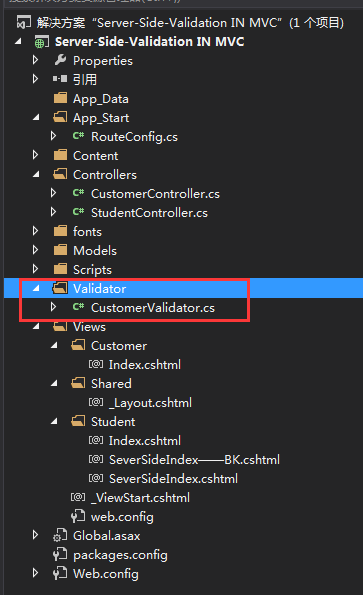жӮЁеҘҪпјҢзҷ»еҪ•еҗҺжүҚиғҪдёӢи®ўеҚ•е“ҰпјҒ
иҝҷзҜҮж–Үз« е°ҶдёәеӨ§е®¶иҜҰз»Ҷи®Іи§Јжңүе…іASP.NET MVC5йӘҢиҜҒд№ӢFluent Validationзҡ„зӨәдҫӢеҲҶжһҗпјҢе°Ҹзј–и§үеҫ—жҢәе®һз”Ёзҡ„пјҢеӣ жӯӨеҲҶдә«з»ҷеӨ§е®¶еҒҡдёӘеҸӮиҖғпјҢеёҢжңӣеӨ§е®¶йҳ…иҜ»е®ҢиҝҷзҜҮж–Үз« еҗҺеҸҜд»ҘжңүжүҖ收иҺ·гҖӮ
Fluent ValidationжҳҜдёҖдёӘејҖжәҗзҡ„.NETзұ»еә“пјҢе®ғдҪҝз”ЁFluentжҺҘеҸЈе’ҢlambdaиЎЁиҫҫејҸпјҢжқҘдёәе®һдҪ“еҒҡйӘҢиҜҒгҖӮFluent ValidationжҳҜдё“й—Ёдёәе®һдҪ“еҒҡйӘҢиҜҒдҪҝз”Ёзҡ„гҖӮе®ғзҡ„дјҳзӮ№жҳҜпјҡжҠҠйӘҢиҜҒйҖ»иҫ‘е’ҢдҪ д»Јз Ғзҡ„дёҡеҠЎйҖ»иҫ‘еҲҶеҲ«ејҖдәҶгҖӮиҝҷе°ұжҳҜAOPзҡ„жҖқжғігҖӮе°ұжҳҜжЁӘеҲҮе…іжіЁзӮ№гҖӮдҪ еҸӘйңҖиҰҒе…іжіЁжҹҗдёҖдёӘжЁЎеқ—гҖӮиҝҷж ·е°ұдҝқиҜҒдәҶд»Јз Ғзҡ„зәҜжҙҒеәҰгҖӮ
Fluent ValidationејҖжәҗең°еқҖпјҡhttps://github.com/JeremySkinner/fluentvalidation
дҫӢеҸҘпјҡ
Aspect-oriented program is a new software development paradigm that enables modular implementation of cross-cutting concerns,and poses difficulties for slicing of aspect-oriented programs.
йқўеҗ‘ж–№йқўзЁӢеәҸи®ҫи®ЎдҪңдёәдёҖз§Қж–°зҡ„иҪҜ件ејҖеҸ‘иҢғеһӢ,иғҪеӨҹе®һзҺ°жЁӘеҲҮе…іжіЁзӮ№зҡ„жЁЎеқ—еҢ–,е…¶зү№жңүзҡ„иҜӯиЁҖе…ғзҙ е’ҢеҠҹиғҪдёәеҲҮзүҮеўһеҠ дәҶйҡҫеәҰгҖӮ
еҘҪдәҶпјҢеәҹиҜқеӨӘеӨҡпјҢзӣҙжҺҘиҝӣе…ҘжӯЈйўҳпјҢ
йҰ–е…ҲжҲ‘们新е»әдёҖдёӘз©әзҷҪзҡ„MVCйЎ№зӣ®пјҡеңЁModelж–Ү件еӨ№дёӢж–°е»әдёҖдёӘзұ»Customerпјҡ
using System;
using System.Collections.Generic;
using System.Linq;
using System.Web;
namespace Server_Side_Validation_IN_MVC.Models
{
public class Customer
{
public string Name { get; set; }
public string Email { get; set; }
}
}然еҗҺж–°е»әдёҖдёӘж–Ү件еӨ№Validator,еңЁйҮҢйқўж·»еҠ дёҖдёӘзұ»CustomerValidator

既然жҳҜиҰҒдҪҝз”ЁFluent ValidationпјҢйӮЈд№Ҳе°ұжҳҜиҰҒеј•з”Ёе®ғзҡ„зұ»еә“дәҶгҖӮ

CustomerValidatorзұ»дёӯпјҢ继жүҝAbstractValidatorжҠҪиұЎзұ»пјҢпјҲPSпјҡиҝҷйҮҢе’ҢEFдёӯзҡ„Fluent APIзұ»дјјпјҢEFдёӯжҳҜ继жүҝEntityTypeConfigurationзұ»пјү
using FluentValidation;
using Server_Side_Validation_IN_MVC.Models;
using System;
using System.Collections.Generic;
using System.Linq;
using System.Web;
namespace Server_Side_Validation_IN_MVC.Validator
{
public class CustomerValidator:AbstractValidator<Customer>
{
public CustomerValidator()
{
RuleFor(s => s.Name).NotEmpty().WithMessage("еҗҚеӯ—дёҚиғҪдёәз©ә");
RuleFor(s => s.Email).NotEmpty().WithMessage("з”өеӯҗйӮ®д»¶дёҚиғҪдёәз©ә");
RuleFor(s => s.Email).EmailAddress().WithMessage("з”өеӯҗйӮ®д»¶ж јејҸдёҚеҗҲжі•");
}
}
}жҺ§еҲ¶еҷЁдёӯзҡ„д»Јз Ғпјҡ
using FluentValidation.Results;
using Server_Side_Validation_IN_MVC.Models;
using Server_Side_Validation_IN_MVC.Validator;
using System;
using System.Collections.Generic;
using System.Linq;
using System.Web;
using System.Web.Mvc;
namespace Server_Side_Validation_IN_MVC.Controllers
{
public class CustomerController : Controller
{
// GET: Customer
public ActionResult Index()
{
return View();
}
[HttpPost]
public ActionResult Index(Customer model)
{
CustomerValidator validator = new CustomerValidator();
ValidationResult result = validator.Validate(model);
if (result.IsValid)
{
ViewBag.Name = model.Name;
ViewBag.Email = model.Email;
}
else
{
foreach (var item in result.Errors)
{
ModelState.AddModelError(item.PropertyName, item.ErrorMessage);
}
}
return View(model);
}
}
}дҝ®ж”№дёҖдёӢпјҢй»ҳи®Өзҡ„и·Ҝз”ұпјҡ
public static void RegisterRoutes(RouteCollection routes)
{
routes.IgnoreRoute("{resource}.axd/{*pathInfo}");
routes.MapRoute(
name: "Default",
url: "{controller}/{action}/{id}",
defaults: new { controller = "Customer", action = "Index", id = UrlParameter.Optional }
);
}
д»Җд№ҲйғҪдёҚиҫ“е…ҘпјҢзӣҙжҺҘзӮ№еҮ»Createпјҡ

иҫ“е…ҘNameпјҢдёҚиҫ“е…ҘEmail

иҫ“е…ҘNameпјҢEmailиҫ“е…Ҙйқһжі•зҡ„ж•°жҚ®

иҫ“е…ҘеҗҲжі•зҡ„ж•°жҚ®пјҡ

иҝҷйҮҢе°ұе®ҢжҲҗдәҶFluent ValidationйӘҢиҜҒгҖӮеӨ§е®¶еҸҜд»ҘзңӢеҲ°пјҢиҝҷж ·зҡ„йӘҢиҜҒжҳҜдёҚжҳҜе№ІеҮҖз®ҖжҙҒеӨҡдәҶпјҢй…ҚзҪ®дҝЎжҒҜйғҪеңЁдёҖдёӘзұ»дёӯпјҢж–№дҫҝз»ҙжҠӨе’Ңжү©еұ•гҖӮдёҚжғіж•°жҚ®жіЁи§ЈйӮЈж ·пјҢжҠҠйӘҢиҜҒдҝЎжҒҜе’Ңе®һдҪ“ж··еҗҲдәҶгҖӮ
е…ідәҺвҖңASP.NET MVC5йӘҢиҜҒд№ӢFluent Validationзҡ„зӨәдҫӢеҲҶжһҗвҖқиҝҷзҜҮж–Үз« е°ұеҲҶдә«еҲ°иҝҷйҮҢдәҶпјҢеёҢжңӣд»ҘдёҠеҶ…е®№еҸҜд»ҘеҜ№еӨ§е®¶жңүдёҖе®ҡзҡ„её®еҠ©пјҢдҪҝеҗ„дҪҚеҸҜд»ҘеӯҰеҲ°жӣҙеӨҡзҹҘиҜҶпјҢеҰӮжһңи§үеҫ—ж–Үз« дёҚй”ҷпјҢиҜ·жҠҠе®ғеҲҶдә«еҮәеҺ»и®©жӣҙеӨҡзҡ„дәәзңӢеҲ°гҖӮ
е…ҚиҙЈеЈ°жҳҺпјҡжң¬з«ҷеҸ‘еёғзҡ„еҶ…е®№пјҲеӣҫзүҮгҖҒи§Ҷйў‘е’Ңж–Үеӯ—пјүд»ҘеҺҹеҲӣгҖҒиҪ¬иҪҪе’ҢеҲҶдә«дёәдё»пјҢж–Үз« и§ӮзӮ№дёҚд»ЈиЎЁжң¬зҪ‘з«ҷз«ӢеңәпјҢеҰӮжһңж¶үеҸҠдҫөжқғиҜ·иҒ”зі»з«ҷй•ҝйӮ®з®ұпјҡis@yisu.comиҝӣиЎҢдёҫжҠҘпјҢ并жҸҗдҫӣзӣёе…іиҜҒжҚ®пјҢдёҖз»ҸжҹҘе®һпјҢе°Ҷз«ӢеҲ»еҲ йҷӨж¶үе«ҢдҫөжқғеҶ…е®№гҖӮ
жӮЁеҘҪпјҢзҷ»еҪ•еҗҺжүҚиғҪдёӢи®ўеҚ•е“ҰпјҒ